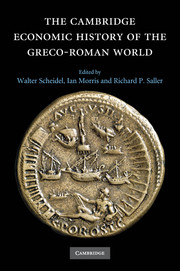Book contents
- Frontmatter
- 1 Introduction
- Part I Determinants of Economic Performance
- Part II Early Mediterranean Economies and the Near East
- Part III Classical Greece
- Part IV The Hellenistic States
- Part V Early Italy and the Roman Republic
- 18 Early Rome and Italy
- 19 The Late Republic
- Part VI The Early Roman Empire
- Part VII Regional Development in the Roman Empire
- Part VIII Epilogue
- Bibliography
- Index
- Map 1.1 The Mediterranean basin"
- Map 10.1 Greek and Phoenician trade in the period of the Persian Wars"
- Map 11.1 The Achaemenid empire"
- Map 12.1 Greece and Asia Minor"
- Map 15.1 The Seleucid empire"
- Map 16.1 Greco-Roman Egypt"
- Map 20.1 The Roman empire at the accession of Vespasian"
- References
19 - The Late Republic
from Part V - Early Italy and the Roman Republic
Published online by Cambridge University Press: 28 March 2008
- Frontmatter
- 1 Introduction
- Part I Determinants of Economic Performance
- Part II Early Mediterranean Economies and the Near East
- Part III Classical Greece
- Part IV The Hellenistic States
- Part V Early Italy and the Roman Republic
- 18 Early Rome and Italy
- 19 The Late Republic
- Part VI The Early Roman Empire
- Part VII Regional Development in the Roman Empire
- Part VIII Epilogue
- Bibliography
- Index
- Map 1.1 The Mediterranean basin"
- Map 10.1 Greek and Phoenician trade in the period of the Persian Wars"
- Map 11.1 The Achaemenid empire"
- Map 12.1 Greece and Asia Minor"
- Map 15.1 The Seleucid empire"
- Map 16.1 Greco-Roman Egypt"
- Map 20.1 The Roman empire at the accession of Vespasian"
- References
Summary
introduction
Conventionally enough, this chapter will attempt to answer questions about economic growth: did per capita GDP grow in the late Republic, and what determined whether it did or not? Which features of the Roman world assisted growth, which impeded it? It should also be our aspiration to recreate the economic lives of flesh-and-blood people, peasants, slaves, craftsmen – and the rich (who bulk so large in the evidence). Economic history should tell us among other things who went hungry, what work was like, and who could afford every amenity (or, as economists say, utility).
Prime topics therefore will be the actual mechanisms of economic life (their degree of technical development) and their capacity for delivering a decent physical existence, and beyond that the standard of living of each social class or group. This is a fairly mainstream approach: when Douglass North set out his agenda, he included in his notion of economic “performance” the question of income distribution. In addition, we should not neglect the field of “public goods”: it may be important to consider the effects of the Roman habit of allocating plentiful resources to some public “goods,” such as foreign wars and the water supply, and few to others, such as mass education.
There can hardly be said to be one single accepted view of the late-republican economy. An experienced archaeologist has written, with quotation marks admittedly, of an “economic miracle,” which may be an Italocentric view. Gelzer once wrote vaguely but not without reason of the “chronic unhealthiness” of the Roman economy in the period before the civil war of 49 bc, a view which is hard to reconcile with the continuation through this whole century of a high volume of Mediterranean trade (cf. Table 19.1).
- Type
- Chapter
- Information
- The Cambridge Economic History of the Greco-Roman World , pp. 511 - 540Publisher: Cambridge University PressPrint publication year: 2007
References
- 20
- Cited by

